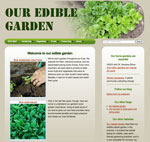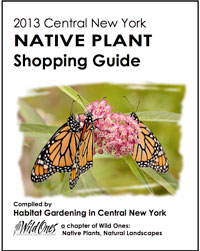Save the Rain
Clean Water Fair
Sept. 7, 9am-2pm
| |
|
Learn about Onondaga County's efforts to clean Onondaga Lake through a variety of activities. For more information, visit the Save the Rain website at http://savetherain.us/2013fair/. This is close to our Plant Sale location taking place the same day and time frame, so it would make a good companion activity.
|
Sara Stein,
Planting Noah's Garden
|  |
Tens of millions [of monarchs] attempt the migration, but the death rate is appalling. During the months-long trip, each life depends on the late-blooming flowers at which it nectars: dots of yellow and purple, goldenrod and aster.
|
| Our Habitat Garden |  |
Visit Our Habitat Garden website for information on providing habitat, earth-friendly gardening practices, plants, and various creatures here in Central New York.
|
HGCNY Officers
| |
| President:
Janet Allen
Vice-President:
Carol Biesemeyer
Treasurer:
Randi Starmer
Secretary:
Soule Leiter
Membership:
Linda Rossiter
Program Chair:
Carol Biesemeyer
Newsletter Editor:
Janet Allen
Additional Planning Committee Members:
Beth Mitchell
Dave Mitchell
John Allen
Peter Huntington
|
| HGCNY on Facebook |
As as more of us participate on our Facebook page, this will become a useful resource for asking (and answering!) local HGCNYers' questions about habitat gardening. |
|
Join HGCNY!
|  |
Becoming an official member of HGCNY is easy: just join Wild Ones! Basic household membership is $37/year, but there are other options, too. (See membership application or website.)
Wild Ones
P.O. Box 1274
Appleton, Wisconsin 54912-1274
Make checks payable to Wild Ones.
Or telephone toll-free 877-394-9453.
|
|
Our Edible Garden
|  | Visit OurEdibleGarden.org to see an example of a Central New York edible garden, the perfect companion to your habitat garden.
|
|
Native Plant Sale Saturday Sept. 7 | Flowering raspberry
(Rubus odoratus) |
The annual HGCNY plant sale will be held on Saturday Sept. 7 from 9:30 am to noon. Plants not sold on Saturday will be available on Sunday Sept. 8 from 1 pm to 3 pm. Location: At the Allens ( directions). We will have plants from The Plantsmen, Amanda's Garden, and Maple Hill Landscaping along with plants donated by HGCNYers. Most plants will be in the range of $4 to $10. If there are particular plants that you want please let us know and we'll try to acquire them and, if numbers are limited, hold them for you. Send your requests to John at ediblecny@gmail.com. Shrub and tree seedlings Tree and shrub seedlings will also be available by ordering in advance NO LATER THAN TUESDAY SEPTEMBER 3. Order NATIVES ONLY, please! These pre-orders will be available at the sale on Saturday. To see what shrubs and trees are available go to www.whiteoaknursery.biz and click on "Potted Seedlings". To cover the additional costs of the container and delivery and as a small contribution toward the cost of our monthly programs, our price will be $5 more than the price listed on the White Oak Nursery website. To order the seedlings email John listing the name of the tree or shrub, the number you want, and the price, i.e. the White Oak Nursery price + $5. If you're not able to pick them up on Sat., Sept. 7 between 9:30 am and noon, indicate that you need to arrange another time/date. Plant donationsIf you have plants to donate ( NATIVE ONLY, please!), you can bring them between 8 am and 9 am the day of the sale or by arranging a time with John a day or two earlier. People who bring plants between 8 am and 9 am on the day of the sale will have the opportunity to buy plants prior to the 9:30 am starting time. Thank you for participating in our plant sale! It not only gets native plants planted in CNY for the benefit of people and wildlife, but also funds this newsletter, our programs, and other projects!
Janet Allen
President, HGCNY
|
|
|
Close doesn't count!
 | | Dogbane |
Dogbane (Apocynum) is a native plant related to milkweed, but which nevertheless is NOT a monarch larval host plant.
Dogbane is often mistaken for milkweed, and it even has white milky sap as does milkweed. One characteristic that helps identify dogbane is its distinctive branching structure, different from that of milkweeds.
 | | Dogbane seedpod |
Its seedpods are long and spindly, hanging downward.
Some Native American tribes used the fibers of one species of dogbane, Hemp dogbane (A. cannabinum), to make thread that was reputed to be finer and stronger than the best cotton thread.
Dogbane can be aggressive - not something you'd plant in a garden. If you look around in natural areas, you'll likely see some. But don't expect to see monarch caterpillars munching the leaves! |
|
With fall, comes goldenrods
 | | Wreath goldenrod |
It's hard to believe that fall is coming. The NYS Fair is one reminder, but goldenrods starting to bloom is an especially vivid and beautiful sign of fall.
When most people think of goldenrods, they think of the most-common goldenrod the Canada goldenrod (Solidaga canadensis). The flower is a golden beauty, but be aware that it travels by rhizome, so it may spread more than you would like.
 | | Zigzag goldenrod |
Fortunately, a number of other goldenrods are native to our area and are very garden-worthy plants, so you'll be able to easily offer the habitat benefits they provide. Although all are golden, the different species look so different that it makes sense to plant them all.
Here's just a few (note that all are Solidago):
Stiff goldenrod (S. rigida) - The attractive leaves growing throughout the season are a plus. And their flattened panicle of flowers in the fall are a bee and butterfly favorite. They grow in sun to part sun, in moist to dry soil, and are about 3-4 feet tall. (A photo is in the Sara Stein quotation in the upper left sidebar.)
Wreath goldenrod (S. caesia) - These fill a different niche since they will grow in shade (as well as in sun) in moist to dry soil. At least in my experience, they arch rather than standing upright, so they're not as vertically tall as others. They really light up a shady area!
Zigzag goldenrod (S. flexicaulis) - It grows in sun to shade, in moist to dry conditions, and is about 3 feet tall. Its name refers to its stems, which literally zigzag from leaf to leaf.
And no, they don't cause allergies!
Goldenrods have become synonymous with allergies despite evidence to the contrary. The most compelling explanation is that goldenrods are insect-pollinated, not wind-pollinated, so they have showy flowers with heavier, stickier, less abundant pollen. Wind-pollinated plants such as ragweed have less conspicuous flowers (since they don't need to attract insects), and lighter, very abundant pollen, much more likely to reach your nose even though your eyes notice the brilliant goldenrod, not the ragweed. And the bad news is that climate change favors an increased load of ragweed pollen. Check out some references about the topic on the Our Habitat Garden website at www.ourhabitatgarden.org/creatures/butterflies-food-fall.html. |
|
Wild for Monarchs -- and for milkweed seeds

We've come a long way this year, both locally and nationally.
Many prominent institutions and organizations (including Wild Ones) formed The Monarch Joint Venture (at www.monarchjointventure.org) with the purpose of restoring milkweeds over large areas, and Wild Ones established its own Wild for Monarchs program (at www.wildones.org/learn/wild-for-monarchs/).
As many of you discovered, though, we experienced this summer the very situation that prompted these efforts: a declining monarch population. We can only hope that conditions this fall, winter, and spring foster a rebound. If so, we'll be ready with mature milkweed plants next summer! In the meantime, we can console ourselves by remembering that milkweed plants are very valuable for pollinators, too, in addition to having attractive, fragrant flowers. Of course, such a profound decline in milkweed plants over the last decades cannot be remedied in one summer, so Monarch Watch is still looking for more local ecotype seeds. For NYS, they're looking specifically for swamp milkweed (Asclepias incarnata), butterfly weed (A. tuberosa), and poke milkweed (A. exaltata). If you planted one of HGCNY's plants from our spring distribution, the seeds you now have are local ecotype! If you'd like to donate some to Monarch Watch, Wild Ones has put together some information in a .pdf document (a fairly large file) to help you participate in this effort. It describes how to collect the seeds, things to watch out for (such as milkweed-seed-eating bugs), as well as the information you need to include. You can mail them to Monarch Watch yourself, or you can bring them to the next HGCNY meeting on Sept. 29 (with all the required information) and we'll mail them. Thank you all for your efforts to leave a legacy of the monarch migration for our grandchildren and for generations beyond.
|
|
|
Native Plant Shopping Guide
 | | Click image to download the Guide |
Are you looking for native plants in general or a particular native plant?
Chances are, you can find them somewhere in CNY.
Our 2013 Native Plant Shopping Guide shows you where. You're welcome to download it by clicking on the image to the right, OR you can download it from our website homepage (midway down the page). It's free!
As always, we recommend that you call ahead if you're looking for a particular plant. Some less common native plants may be in short supply, and you wouldn't want to waste a trip to find that your plant had sold out. |
|
|